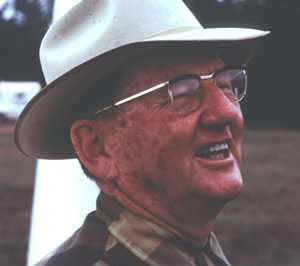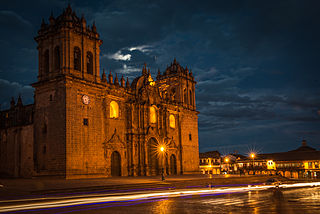
Elim Fellowship is a Finished Work Pentecostal denomination of Christianity. It was founded in 1933 in Lima, New York, United States. It is named for a biblical location named in Exodus 15:27, wherein Elim is described as an oasis in the wilderness.

Frederick Donald Coggan, Baron Coggan, was the 101st Archbishop of Canterbury from 1974 to 1980. As Archbishop of Canterbury, he "revived morale within the Church of England, opened a dialogue with Rome and supported women's ordination". He had previously been successively the Bishop of Bradford and the Archbishop of York.
Charles Caldwell Ryrie was an American Bible scholar and Christian theologian. He served as professor of systematic theology and dean of doctoral studies at Dallas Theological Seminary and as president and professor at what is now Cairn University. After his retirement from Dallas Theological Seminary he also taught courses for Tyndale Theological Seminary. He is considered one of the most influential American theologians of the 20th century. He was the editor of The Ryrie Study Bible by Moody Publishers, containing more than 10,000 of Ryrie's explanatory notes. First published in 1978, it has sold more than 2 million copies. He was a notable proponent of classic dispensationalism.

The conservative holiness movement is a loosely defined group of theologically conservative Christian denominations with the majority being Methodists whose teachings are rooted in the theology of John Wesley, and a minority being Quakers (Friends) that emphasize the doctrine of George Fox, as well as River Brethren who emerged out of the Radical Pietist revival, and Holiness Restorationists in the tradition of Daniel Sidney Warner. Schisms began to occur in the 19th century and this movement became distinct from parent Holiness bodies in the mid-20th century amid disagreements over modesty in dress, entertainment, and other "old holiness standards". Aligned denominations share a belief in Christian perfection, though they differ on various doctrines, such as the celebration of the sacraments and observance of ordinances, which is related to the denominational tradition of the specific conservative holiness body—Methodist, Quaker, Anabaptist or Restorationist. Many denominations identifying with the conservative holiness movement, though not all, are represented in the Interchurch Holiness Convention; while some denominations have full communion with one another, other bodies choose to be isolationist.

William Cameron Townsend was an American Christian missionary-linguist and the founder of Wycliffe Bible Translators and the Summer Institute of Linguistics.

Pastor Humberto Lay Sun is a Peruvian evangelical minister, architect, and politician belonging to the National Restoration Party. He is of Chinese descent. He studied at the Colegio San Andrés. He was also a commissioner on the Truth and Reconciliation Commission that investigated abuses by the Shining Path, Túpac Amaru Revolutionary Movement, and the Military of Peru during the 1980s and 1990s. He was a Congressman representing Lima for the 2011–2016 term.

Wikipedia:

Colegio San Andrés is a private school located in Lima, Peru.
The Evangelical Church of North America (ECNA) is a Wesleyan-Holiness, Protestant Christian denomination headquartered in Clackamas, Oregon. As of 2000, the Church had 12,475 members in 133 local churches. The Church sponsors missionaries in seven countries.

Christianity is the most widely professed religion in Peru, with Catholicism being its largest denomination.

German Peruvians are Peruvian citizens of full or partial German ancestry. In general, the term is also applied to descendants of other German-speaking immigrants, such as Austrians or the Swiss, or to someone who has immigrated to Peru from German-speaking countries.
John A. Mackay was a Presbyterian theologian, missionary, and educator. He was a strong advocate of the Ecumenical Movement and World Christianity.

The United Church of Christ in the Philippines is a mainline Protestant denomination in the Philippines. Established in its present form in Malate, Manila, it began as a uniting church after the merger of the Evangelical Church of the Philippines, the Philippine Methodist Church, the Disciples of Christ, the United Evangelical Church and several independent congregations.
John Theodore Bendor-Samuel was an evangelical Christian missionary and linguist who furthered Bible translation work into African languages, as well as making significant contributions to the study of African linguistics. Amongst his friends and colleagues he was widely known by his initials, JBS.
The Evangelical Presbyterian and Reformed Church in Peru was established by missionaries from the Free Church of Scotland. In 1915, San Andres College was founded by John A, Mackay. Medical work was centered in Moyobamba and Cajamarca. The first church work was started in 1921. The first church was built in Cajamarca in 1936 with 600 people present. The work spread to Tarapoto and Chachapoyas. But there was shortage of pastors and elders. The first General Assembly was held in 1963 with 5 presbyteries namely the Amazonas, Cajamarca, Lima, Celendin and San Martin, and the church become independent. The name of the denomination was Evangelical Presbyterian Church of Peru. The church had 3,000 members.
Jose de Segovia is a Spanish teacher, journalist & theologian. He studied journalism at Universidad Complutense (Madrid), theology at University of Kampen (Netherlands) and Bible at The School of Biblical Studies Welwyn (England), where he became interested in the work of preacher Martyn Lloyd-Jones. De Segovia is currently leading active student groups such as European Mission Fellowship, International Fellowship of Evangelical Students and Unión Bíblica. He was also President of the Theological Commission on Spanish Evangelical Alliance between 2001 and 2015 and representative of the World Evangelical Alliance in theological dialogue with the Vatican.
Rodolfo González Cruz is a Cuban–Peruvian evangelical pastor, missionary and writer, also known for his business ventures and his support for political causes. He was the founder of the Worldwide Missionary Movement in Peru. An anti-communist and a defender of youth and marriage, for which he was recognized by various Peruvian authorities. The works he promoted included an international media network, Bethel Television, and a radio network known as Bethel Radio, of which He was president and promoter of these two chains named in one, Bethel Communications, he installed commercial establishments for the sale of books with Christian foundations designated as Altamira Investments. He founded schools, institutions and educational communities called Elim International, aligned to theological bases, located in different urban and regional venues of the Peruvian territory globally called Elim Educational Association.









